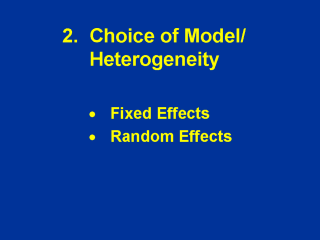 |
When combining the outcomes from
different studies, one may use a fixed and/or random effects model. A fixed effects model
assumes that all the studies share the same common treatment effect while a random effects
model assumes that they do not share the same common treatment effect. In the absence of
significant heterogeneity, which is often calculated using what is known as the Q
statistic, both the fixed and random effects models will yield similar confidence
intervals. However, if significant heterogeneity is present, the random effects model will
yield wider confidence intervals. Recent research suggests that the random effects model
is preferable to the fixed effects model (See: Hunter JE, Schmidt FL. Fixed effects vs.
random effects meta-analysis models: implications for cumulative research knowledge. International
Journal of Selection and Assessment 8:275-292, 2000). |
